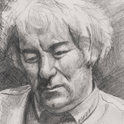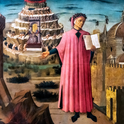Kei Miller is a multi-award-winning poet and novelist. Born in Jamaica in 1978, he came to the UK in 2004, and 10 years later won the Forward Prize with his collection The Cartographer Tries to Map a Way to Zion.
The book explores how colonialism affected Jamaican identity and is built round a dialogue between a Rastaman and a mapmaker about how we know the world, specifically Jamaica. What is the truest way to measure—by scientific cartography which controls and names land by mapping it, or by indigenous feelings about your own home?
In “Quashie’s Verse”, the fourth poem in the book, the word measure appears three times. It is a battle over shaping a poem, using its own shape to make its case:
But what now
is the length
of Quashie’s
verse? He
who can no longer
measure by kend or by
chamma or by ermijja; he who
knew his poems by how they fit
in earthenware, perfect as water,
words shaping themselves against red
clay grooves. And though no two jars were
precisely like each other – it worked for Quashie
this ‘just about’ measure – for words are like that
each one carrying its own distance. Even this, despite
its best shaping efforts, will never quite be a
jar. So what now shall Quashie do—his old
measures outlawed, and him instructed
now in universal forms, perfected by
universal men who look nothing
and sound nothing
like Quashie?
Shaped poems, which use words’ configuration on a page as an extra way to get over what the poem is about, arrived early in the European tradition. Poems shaped like a hatchet, wings, pan pipes or an egg survive from Greek Alexandria in the 3rd and 2nd centuries BCE. In 17th-century Europe, we see shaped religious poems (George Herbert’s “Easter Wings” and “The Altar”) and poems about drinking in the shape of flagons (by François Rabelais in French, for instance, or Johann Michael Moscherosch in German). Later on, the fin de siècle calligrams of Apollinaire triggered 20th-century interest in “concrete poetry”.
I suspect “Quashie’s Verse” is also in dialogue with other famous “jar poems” from the western canon. Wallace Stevens’s enigmatic poem “Anecdote of the Jar” (1918), shows humanity imposing order and meaning on “wilderness”. Its speaker “placed a jar” on a hill in Tennessee, which “took dominion everywhere”—another colonising moment. Stevens also seems to tease Keats’s “Ode on a Grecian Urn” (1819)—which ends “Beauty is truth, truth beauty. That is all/ Ye know on earth, and all ye need to know”—in his own vision of how American art can find beauty and truth: not by looking back to ancient Greece, but by taking on the “slovenly wilderness” of a poetically unmapped new world.
“Quashie’s Verse”, opening with but, seems to challenge both those poems, now (another word appearing three times) that a colonising mindset has arrived in Jamaica, bringing with it western poetry’s prescriptive measures.
“Measuring” is important for poems as well as geography. But where can beauty and truth be found or made here, in this place with its own local materials, now that colonialism is imposing universal forms?
Quashie is a derogatory Jamaican term for a country bumpkin. Before colonialism, Quashie made poems (presumably oral) perfect as water, measuring the words by systems based on the body. In the Ethiopian Amharic language, which is spoken—and held sacred—by Rastafarians in Jamaica, kend is the distance from elbow to middle finger-tip, chamma is a cotton garment, ermija the length of a stride. These “just about” measures, which Europeans do not know, worked for Quashie. He knew his poems by how they fit/ in earthenware: a perfect image for a well-made, established, indigenous poetic tradition.
Further down the poem-jar, the opening question is echoed in a way that makes composing poetry a much larger ethical question: What now shall Quashie do? His old measures are outlawed: the jar narrows towards its base as if Quashie is straitjacketed by that repeated word universal, which contains verse but also suggests “uni-form”—as in, only one form.
The answer to that question, perhaps, is that you have to fuse both traditions: the indigenous feeling ways of Quashie and a universalising, objective-seeming mapping. Miller recently published a book of essays, Things I Have Withheld, about silences, even within friendships, around everyday racism—which turns on understanding painfully different mindsets.
This poem embodies that answer. By breaking a from jar at the end of the 15th line, it sneakily presents itself as “ajar”, between western tradition and the just about shapes of Quashie’s verse. Standing up beside an American jar in Tennessee and an English Grecian Urn, it presents itself as earthenware (as in Quashie’s poems), made by using sophisticated techniques from the very western tradition that threatens Quashie’s verse.
With no end-rhymes, the poem is held together musically by inner vowels. The ER sound of the key word verse (line 4) echoes through the poem’s first half in earthenware, perfect, words, were, worked, words (lines 9, 10 11, 12, 13); reappears in perfected (line 18); and in verse again, now hidden in universal (18, 19). The AY sound of shaping (line 10), echoed in clay (line 11) and repeated again in shaping (line 15), suggests that Quashie’s human creations are close to God’s creation of humanity out of clay.
I suspect a religious pun here, too: Rastafarian religion, which runs throughout the book, calls God “Jah”, short for Jehovah. An earlier poem describes unmapped Jamaica as a shrug of Jah. A later poem is a sermon by the Rastaman (who wins over the cartographer), telling its listeners to go forth, anointed by your own storage. His listeners will be filled, like a jar—and maybe even by Jah—with upfullness: a happy holy goodness of their own.
That word own is crucial for the book’s whole argument about possession and dispossession—of the land, the island, the languages—in Jamaica. Miller’s skill, framing political injustice in terms of poetry (while laughing at itself, too, in best shaping efforts), deploys tools of the colonising poetic tradition to generate sympathy with the colonised. Quashie’s measures are outlawed in his own land; he is dispossessed of his own verse-making. But his words carry their own distance. Physically, that word own is the heart of the poem, the centre of the jar.
¶ “Quashie’s Verse” is reproduced from Kei Miller’s The Cartographer Tries to Map a Way to Zion (Carcanet, 2014)









